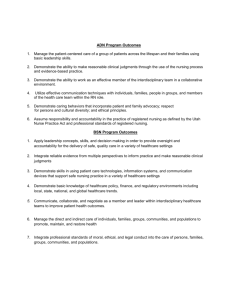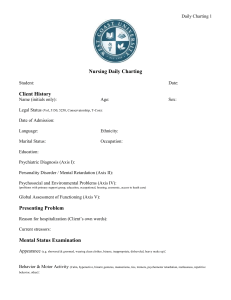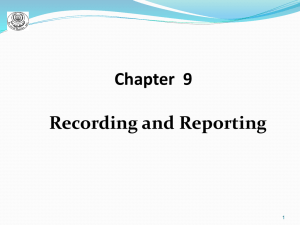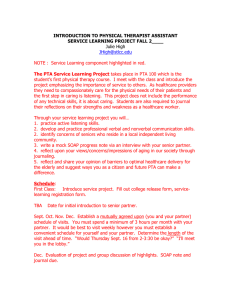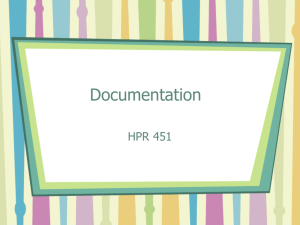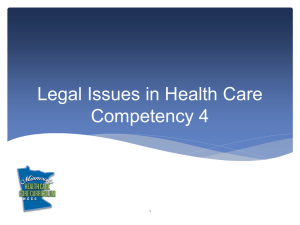Documentation
advertisement
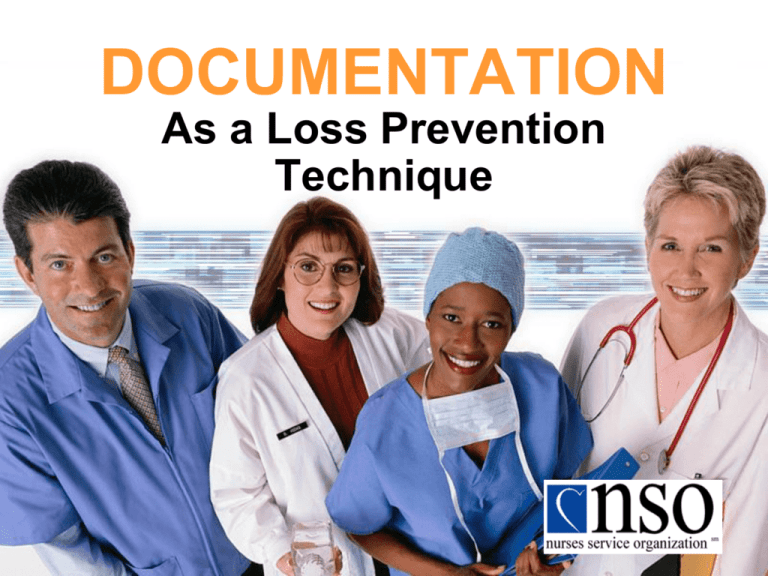
DOCUMENTATION As a Loss Prevention Technique Today’s Objective » Increase awareness of documentation risks, specifically targeting exposure to negligence and malpractice claims. » Enhance the quality of documentation by expanding awareness in order to provide quality patient care and avoid malpractice incidents. » To address the documentation steps in order to implement, and thus help protect your patient from harm and minimize your liability exposure. 2 Legal Perspective on Documentation • Not documented, not done. • Poorly documented, poorly done. • Incorrectly documented, fraudulent. 3 Quality Documentation is Quality Care • Structured writing typically inspires structured performance. • Document the Nursing Process: Assessment Diagnosis Planning Implementation Evaluation 4 You are what you document A well-documented patient care record: Protects your patient Demonstrates to the board of nursing that you are a competent nurse. Minimizes the potential of being named as a defendant in a lawsuit. Minimizes the potential of a court appearance if you ARE named in a suit. Help you win if you go to court. 5 The Patient Care Record is a Legal Document. • Under state laws, the patient care record is the property of the health care provider. • Patient is entitled to a copy of the record under the laws of most states. • The record must reflect accurate and contemporaneous information. • The patient care record documents the care provided. 6 Basis for Reimbursement Your documentation may influence how you and your employer are reimbursed for services rendered and minimize financial loss. 7 Considerations for Quality Documentation Contemporaneous documentation Accurate documentation Fraudulent documentation Inappropriate documentation 8 Documentation as a Loss Prevention Technique • Documentation Dos and Don’ts: • 10 Risk Management Strategies 9 Risk Management Strategy 1 Do not erase. Do not use “white out”. Do not cross out an error with more than one line. 10 Risk Management Strategy 2 Record only the facts. Document only observed behavior. Document healthcare services rendered. 11 Risk Management Strategy 3 Do not write critical comments. Do not document your opinions. 12 Risk Management Strategy 4 Begin each entry with the date and time and end each entry with signature and title. Example: (03/31/09 - 7:50AM - Jane Doe, BCCNS) 13 Risk Management Strategy 5 Do not leave blank spaces. 14 Risk Management Strategy 6 Record all entries legibly and in ink. 15 Risk Management Strategy 7 Avoid generalized phrases such as "bed soaked" or "a large amount." 16 Risk Management Strategy 8 If an order is questioned, document that clarification was sought and discussed. 17 Risk Management Strategy 9 Document only your own observations and patient services rendered. 18 Risk Management Strategy 10 Do not permit any visiting relative or other third-party access to the patient care record. 19 Communication Challenges Attributes: » Factual » Accurate » Current » Confidential 20 Reporting Challenges Nurses must communicate information about patients to other nurses and other health care workers. Oral Report – Typically, conducted at change of shift. Documentation/Written Report – Completed during shift. 21 Documentation Techniques Strengths and Weaknesses Documentation Methods • Charting by Exception • FOCUS • Narrative • SOAP • Electronic 23 Documentation Methods • Charting by Exception 24 Documentation Methods • FOCUS 25 Documentation Methods • Narrative 26 Documentation Methods • SOAP 27 Documentation Methods • SOAP (SOOOAAP) 28 Documentation Methods • Electronic 29 Effective Risk Management Strategies • Comply with Nurse Practice Act • Practice Competent Nursing • Comply with Policies and Procedures • Follow Appropriate Incident Reporting 30 Incident Reporting Losses can be reduced by a timely, prudent, and compassionate response to an incident! 31 Learn Your Organization’s Guidelines Examples of Reportable Incidents • Patient falls • Treatment-related injuries • Medication errors • Missed/incorrect diagnosis • Equipment failure • Employee exposures • Complaint by patient, family, visitor 32 BE ALERT! Report unusual occurrences Document ONLY the facts • Report immediately, i.e., within 24 hours. • Do not speculate. • Do not draw conclusions. • Do not document impressions. 33 QUALITY MONITORING • Participate in investigations. • Maintain confidentiality of all information. 34 Open Charting • Encourages patients to review their own patient care record Promotes meticulous documentation by healthcare providers Fosters patient inclusion in the healthcare delivery process Requires significant time May raise patient queries regarding the healthcare delivered 35 Documentation Examples 36 37 38 39 40 41 42 43 Documentation Bloopers • • • • • • • “The patient refused an autopsy.” “The patient has no previous history of suicides.” “Patient has left white blood cells at another hospital.” “On the second day, the knee was better, and on the third day it disappeared.” “The patient has been depressed since she began seeing me in 1993.” “Discharge status: Alive but without permission.” “Healthy appearing decrepit 69year old male, mentally alert but forgetful.” • • • • • • • • • “Patient had waffles for breakfast and anorexia for lunch.” “She is numb from her toes down.” “While in ER, she was examined, x-rated, and sent home.” “The skin was moist and dry.” “Patient was alert and unresponsive.” “Rectal examination revealed a normal size thyroid.” “She stated that she had been constipated for most of her life, until she got a divorce.” “Skin: somewhat pale but present.” “Patient has two teenage children, but no other abnormalities.” 44 THE END

